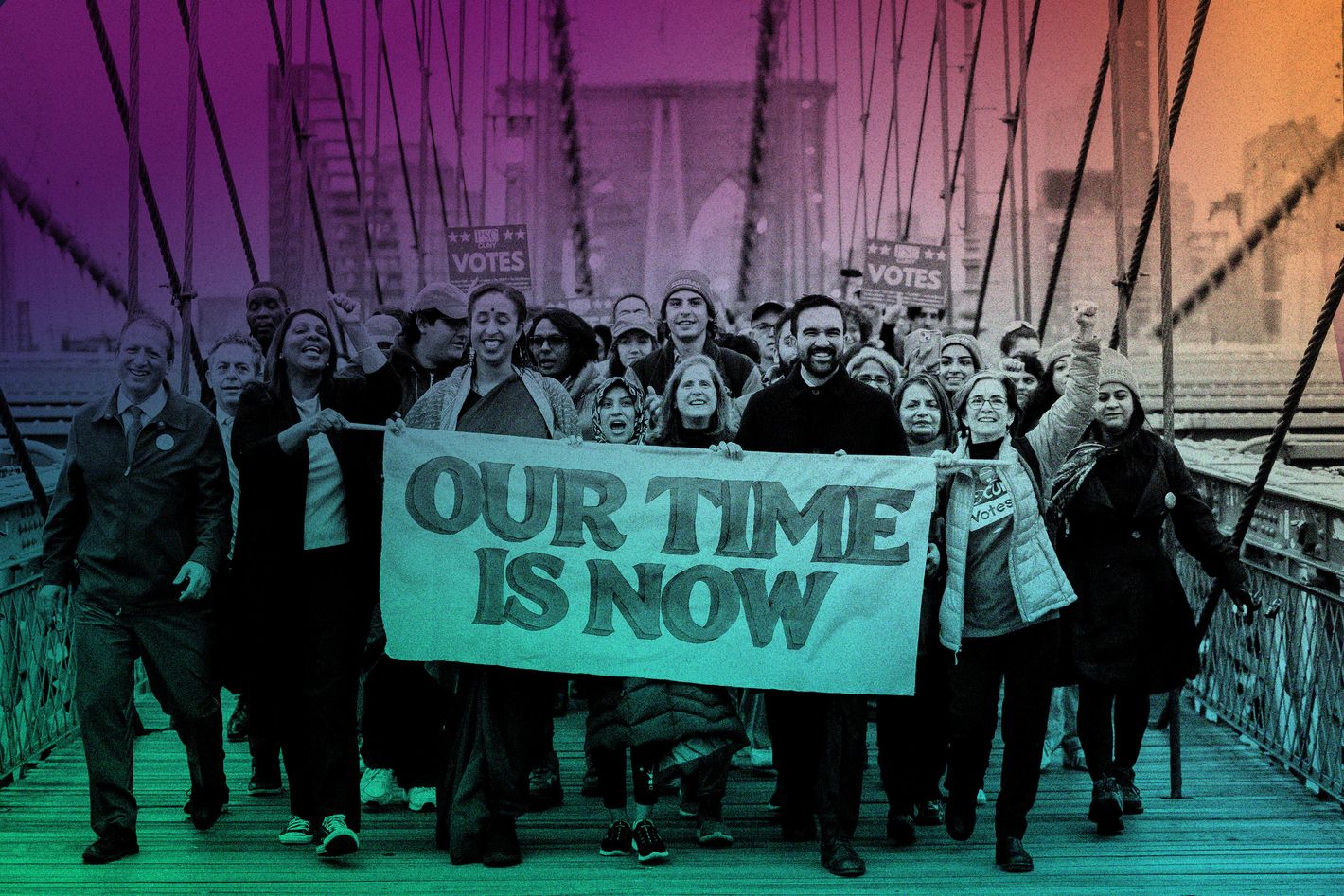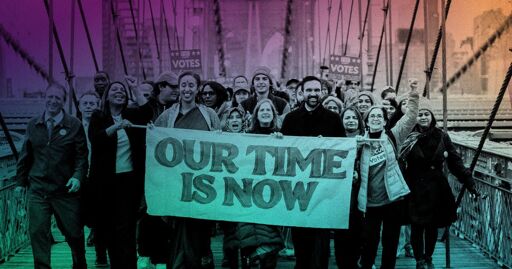
Photo: Adam Gray/Bloomberg via Getty Images
Zohran Mamdani secured his place in history Tuesday night by winning the election to become New York City’s first Muslim and South Asian mayor, elevated to victory over Andrew Cuomo and Curtis Sliwa by the strength of his multiracial coalition of supporters. Political analyst Michael Lange has followed the highly-competitive race from its earliest days and quickly became a prominent voice in the local politics scene due to his block-by-block breakdowns of the city electorate and his prediction of Mamdani’s unexpected primary victory. I caught up with Lange this morning for his immediate takeaways from the results, how Mamdani’s base of support changed from the primary, and what he didn’t see coming.
On Monday, you put out your long-awaited prediction **for the mayor’s race, estimating Mamdani would win with 52.3 percent of the vote. Right now, his total is holding a little over 50 percent with more than 90 percent of the vote counted. How did last night compare with what you were seeing in the lead up to the election?**Yeah, I’m 1.9 percent off as of now. With some of the provisional ballots, I think it’ll get a little closer. Like the mail-in stuff, there’s still probably 200,000 plus votes that haven’t been counted that’s traditionally a little bit more of a Democrat, left-leaning sample. So we’ll see. My Mamdani coalition predictions by borough, I think, were very pretty spot on. But I was wrong about how much support for Curtis Sliwa would completely erode. I mean, Cuomo whittled him down to 7 percent. That’s really, really low. Cuomo’s gonna double his vote total from the primary, gonna get 900,000 votes, but Mamdani added 500,000 plus from the primary, at least and that’s why he’s gonna win. He added them, not just in his base, but really the big thing is that he expanded his coalition into more Democrat, but also far more working-class Black and Hispanic neighborhoods: Eastern Brooklyn, Southeast Queens, the North Bronx, the South Bronx, Upper Manhattan. Like really consolidating support. And, without that, he definitely doesn’t get to 50 percent. He might not even win without that. And so, I think it really mattered.
But also, some of the stuff I was saying about how I think his coalition is becoming even more working class and even more focused on the people in the middle, I think that bore out in the results. The “multiracial working class” and middle class, too. And then again, your middle class, upper middle class, younger college educated professionals who rent. That middle — which is really nuanced and diverse and interesting — that was all the way with him. Cuomo, once again, had the very wealthiest and some of those folks at the very bottom. And then he still had the white ethnic middle class, they really came out for him in pretty large numbers.
He also did quite well not just in the Orthodox and the Hasidic neighborhoods, but in more middle-class Jewish areas like Forest Hills, Kew Gardens. He did better there than I thought he would. He also did well in Riverdale. I kinda saw that one coming. It’s a little bit hard to tell from some of the results how Chinese American voters and East Asian voters performed, just because sometimes they’re not exclusively limited to homogenous communities. But I think it’s another data point there, that is a bit more of an ideologically conservative voting bloc we’ve seen the last couple cycles. But it still wasn’t enough and it was because Cuomo lost a lot of his Black and Hispanic working class support and I think that did him no favors. But really interesting results, almost more interesting than the primary, just because of all the turnout.
**What surprised you the most?**The sheer subsuming of Curtis Sliwa’s coalition. I mean, I thought I put Curtis Sliwa down by having him on 11 percent. I thought that was pretty low end, right? He has 7 percent. That is so little. So I think that was a little surprising.
I thought the Black neighborhoods would be a tiny bit more split. Cuomo really only won a handful of older, very old developments, some public housing. Like the senior centers, the places where 80 percent of the electorate is over 60. He still did well there. But Mamdani won like every precinct in Canarsie. He really won almost every precinct in Southeast Queens, absent like Rochdale Village. It was a strong performance in Black neighborhoods for him. I wouldn’t say that’s surprising, but I think it’s very noteworthy.
And I think there were Trump-Mamdani voters, but they were not the white working class. They were the Puerto Rican, South American, South Asian, Muslim working class. The Brighton Beach precincts in the primary, there’s one block that was 75 percent Trump last November and this time Mamdani won it with a plurality because all the Pakistani Muslims in the neighborhood voted for him. But he did very well in Corona, Queens. He did well in Elmhurst. In Corona, Cuomo won a precinct or two, so it wasn’t a clean sweep, per se. But Mamdani did well in those areas. He did well in the immigrant neighborhoods that had pronounced swings to Trump, absent, I would say, the more Chinese-American communities, which I think is interesting and just another kind of data point to where our politics are. I think the Trump endorsement mattered, but I think it was also a lot of tactical voting.
It was crazy just how high the turnout was. I’m really going to be curious once I get the voter file and can see, racial-percentage wise, what this electorate looked like. But there was high turnout, really, for key parts of both coalitions. You just felt like there was so much on the line. And I think had Zohran not run what turned out to be, I think, a very strong general election campaign, this could have gone way differently.
**Mamdani is clearing a million votes and counting. Is there a sense that this is a result of motivating the electorate or is this a result of the extensive voter outreach and registration his campaign did?**The salience of national politics and Trump being in the White House, I think, certainly contributed to a lot of the white collar turnout being higher. But also this was a very competitive race where the mediums where people consume news and information were flooded. We just saw so much advertising and attention. New York City hadn’t really seen a municipal campaign like that in a long time and I think Mamdani really gave people something to vote for. Andrew Cuomo couldn’t quite do the same thing. He did kind of play the fear card and the fear card, it didn’t get him a win, but it got him 41 percent. Without Mamdani, I don’t know if the turnout’s like this. And I think it’ll be very interesting to kind of see what turnout is like in primaries and general elections next year. I think we might think that this is the new norm, but candidates like Zohran are not around all the time. I think AOC could inspire turnout like this. But you can’t just will this into existence. I think it’s dependent on macro factors and also the candidates. And Mamdani, people discussed his general election campaign a lot. I thought the cadence was different for a lot of it. And, comparing to the primary, the bar is so high. I thought he closed really strong.
We’re still waiting for the final slice of election returns. Do we know where votes are still outstanding and what are your expectations? So, the last percentages reporting, in the primary the last batch boosted Mamdani from 43.5 percent to 43.8 percent. And also in the presidential election, when the other ballots came in, Kamala Harris like went up four tenths of a percent. Donald Trump went down like five tenths of a percent. So, the last two elections show that some of these returns trend towards Democrats, Mamdani Democrats, you could say. Liberals, maybe. But the mail in ballots and things skew older. I do think excellent chance he stays over 50 percent, solid chance he rises from 50.4, 50.6, 50.7. It could be 200,000 votes that are just outstanding, you know? But I think there’s a very, very strong chance he stays above 50. And look, did he get 60 percent? No. But over 50 with 1.075 million votes, 1.1 million votes, whatever he finishes at — we’re throwing around the mandate word, but that’s a real show of support.
The flip side of the coin though is that there’s 40 percent of this citywide electorate — though it’s just a small percentage of the people who live here — that are pretty against Mamdani. I think the way to mitigate that is to continue to build your support in these Black and Hispanic neighborhoods. Cuomo, for all of the poor campaigning that he did, he is kind of a unique guy in terms of that he can unite the ultra-wealthy, the pro-Israel, the Italian and Irish white ethnics, and older Black and Hispanic voters. That’s kind of rare. So, I think if you’re Mamdani, you want to not only build the widest possible coalition because it’ll help you govern, but also it’s like: someone who runs against me, where are they trying to consolidate support? Looking ahead to that, I think it’ll be a challenge for people to do that. He’s got a real opportunity to build his support with some of the most Democratic constituencies, and I think we’re in for a fascinating ride. Not only for the election, the other candidates that it will inspire, but just watching him govern.
More on the election
A Euphoric First 162 Minutes in Zohran’s New YorkScenes From Your Election NightWhat Curtis Sliwa Told Zohran Mamdani on Election Night
From Intelligencer - Daily News, Politics, Business, and Tech via this RSS feed

